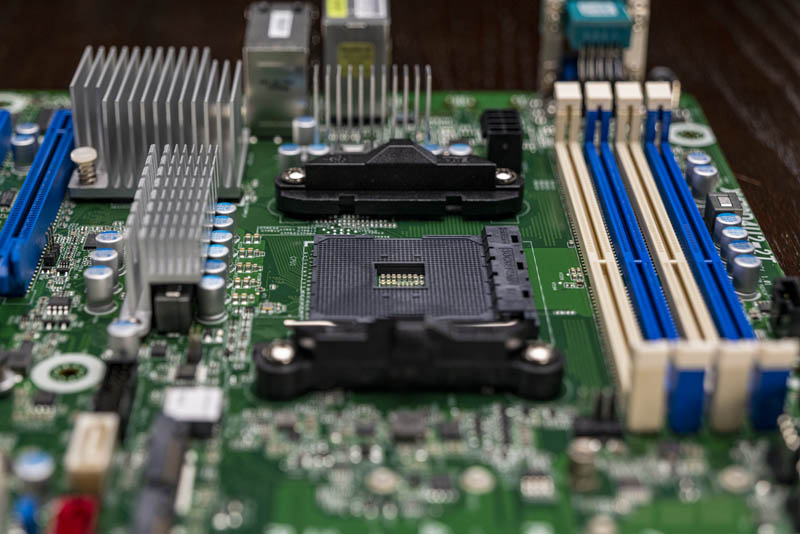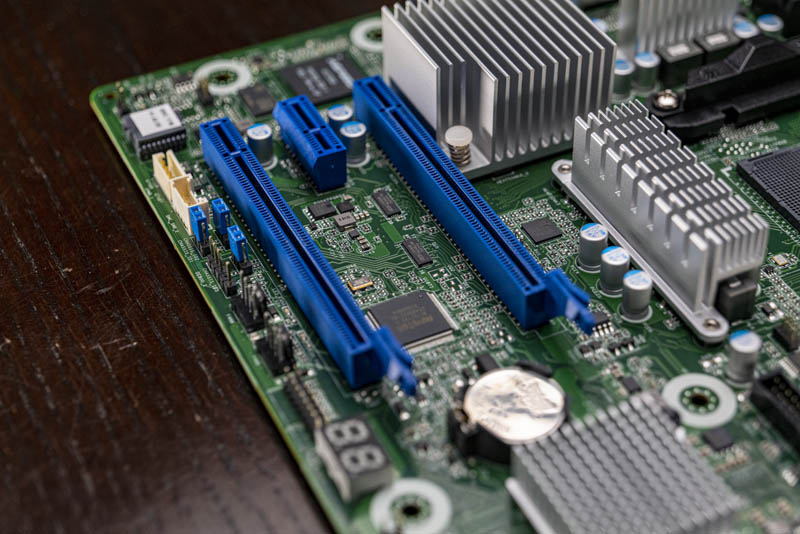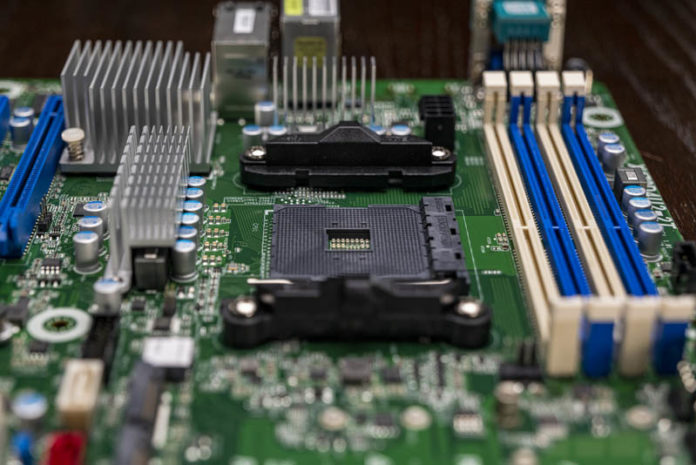Today we are looking at the ASRock Rack X470D4U2-2T. This is our second review in our coverage of ASRock Rack’s line of AMD Ryzen-based server motherboards. Previously we looked at the X470D4U, and while these two motherboards are very similar they do have some key differences. Since the market is so small for AMD Ryzen server platforms, and ASRock Rack is doing a lot of innovation here, we are going to give their second model a formal review.

ASRock Rack X470D4U2-2T Overview
The ASRock Rack X470D4U2-2T is a mATX motherboard measuring 9.6” x 9.6”. In that form factor, you get the AM4 socket which accepts Ryzen CPUs.

The official CPU support list starts at the Ryzen 2000 series and covers all the way to the top of the Ryzen 3000 series stack with support for the Ryzen 9 3950X. Officially, this list excludes the first-gen Ryzen 1000 series parts. We can confirm both the original Ryzen 5 1600 and the Ryzen 5 1600 AF CPU, which is derived from the Zen+ architecture used on the 2000 series CPUs, work without issue. With that information, it is likely the entire Ryzen 1000 line will work as well. Still, since it is technically unsupported, we wanted to present what we found for our readers.

Given the Ryzen CPU, there is dual-channel memory support for up to four DDR4 unbuffered DIMMs at speeds up to DDR4-3200. ECC memory support is included, and the relatively new 32GB ECC DDR4 2666 DIMMs are supported, giving a maximum memory capacity of 128GB.
During testing, one challenge was encountered with regards to the physical location of the CPU socket in relation to the memory slots. The Ryzen CPU being used for testing was installed with the stock cooler, specifically the AMD Wraith Stealth. This may not be the fanciest cooler, but those who are looking at this Ryzen-based solution for cost savings may want to use the boxed cooler to save additional expenditures.The first memory slot on the X470D4U2-2T is so close to the CPU socket that it is blocked from use while the Wraith Stealth cooler is installed. The fan on the cooler even makes light contact with the DIMM in the second memory slot.

A taller cooler like the Wraith PRISM would not have this problem, but other Ryzen coolers might encounter difficulty. Also, users with taller DIMMs than we tested with will certainly encounter problems with both slots 1 and 2. For typical server-style passive heatsinks this is not an issue. Still, for those looking to save money and making an inexpensive edge server (e.g. a NAS) with the stock cooler, this is an important challenge to consider.
Based on the AMD X470 chipset, this motherboard is limited to PCIe Gen3, even when populated by a Ryzen 3000 series CPU that would otherwise support Gen4. There are two PCIe x16 slots and an x1 slot. Only the first top x16 slot can operate at x16 link speeds. The second x16 slot is electrically x8, and if both x16 slots are occupied they automatically operate at x8/x8. In a difference from the X470D4U, which has an x8 (electrical x4) slot between the two x16 slots, the X470D4U2-2T only has a PCIe Gen2 x1 slot. In exchange for that lost slot, the PCIe Gen 3 x4 connectivity is used for the dual 10 GbE powered by the Intel X550-AT2 controller.

There are also two M.2 slots on board, but neither runs at the maximum PCIe 3.0 x4 speed as you might expect. M2_1 can operate at PCIe 3.0 x2 or SATA III, while M2_2 operates at PCIe 2.0 x4. If you want more PCIe connectivity, we suggest moving to AMD EPYC 3000 or EPYC 7000.

Additional storage is handled by the 6 onboard SATA III 6.0gbps ports provided by the AMD X470 chipset. This includes one port with support for SATA DOMs. Unlike the X470D4U, there is no Asmedia controller for an additional pair of SATA ports.

Rear I/O is limited; only two USB 3.0 ports are exposed. There is a serial port as well as a VGA output driven by the ASPEED AST2500. That AST2500 has its own dedicated NIC above the USB ports, and there are two 10GbE connections powered by an Intel X550-AT2 controller. This type of I/O layout is typical on a server board and is used to interface with the network and local KVM carts, but it is very different from what we see on consumer Ryzen platforms. This is a server platform, so it makes sense here.

That ASPEED AST2500 is the baseboard management controller and is one of the two defining features of this motherboard (the other being 10Gbase-T.) The BMC will allow out of band management of the system, full remote KVM, and mounting of virtual media over the network. Many of STH’s readers will be familiar with the ASPEED brand of BMC. ASPEED is commonly used on Inspur, Supermicro, Gigabyte, and other vendor boards. We also see them used in hyper-scale servers. An example is when we covered how Facebook Introduces Next-Gen Cooper Lake Intel Xeon Platforms. Its inclusion on a Ryzen board is very nearly unique at this point in time. If you need IPMI support from a Ryzen-based platform to be able to deploy and manage the server remotely, this ASRock Rack X470D4U2-2T is one of the only options around. Coupled with the front to rear chassis airflow, these are some of the changes made to turn a Ryzen platform into a server platform.
ASRock Rack X470D4U2-2T Topology
We wanted to take a quick moment here to show the system topology. We described it in words above but seeing it helps. First, here is the block diagram:

An explanation of that block diagram one can see in our hardware overview above. Here is the topology:

Since this is based on Ryzen, it is a single NUMA node design even when using Zen(+). AMD EPYC 7001 8-core servers, such as those based on the AMD EPYC 7251 had four NUMA nodes which created a lot of inter-die traffic. With Ryzen, one does not have to worry about that these lower-cost platforms.
Next, we are going to look at the CPU options, management, test configuration, and OS testing, before getting to performance and power consumption.





It is a nice board but that price kills it.
X570D4I-2T + 4900X (65W) + 4x 32GB ECC SODIMM = wishful thinking :D
Will – thanks for this review. I have waited three years to see a uATX board with x8/x8 slots. Good points about the low transfer speeds over the BMC, and the DIMM s
ots. Those are real problems. I have been keeping my eye on this board but it looks like it still needs some polish.
Is it normal for the serial port to be male like that? I would have thought 9-pin female was standard for onboard serial.
HedRat,
DB9 serial ports are male, the cables are female.
emerth,
Despite the problems, they’re not insurmountable and I still think that both the X470D4U boards have merit. A taller cooler easily mitigates the DIMM issue, and while the BMC is slow that only really comes into effect during installation of an OS. For day-to-day access like rebooting the system over the IPKVM, it has no effect.
I wonder if STH has actual measurements (dimensions) of the DIMMs they used that made contact with the AMD cooler? Even the exact manufactuer, model, and part number info of the DRAM used in this test would be helpful; some manufacturers might vary their product over time. Any detailed info might help buyers considering their DRAM selection when using that cooler.
AsRock Rack just added another weird board, ROMED6U-2L2T, which is a M-ATX board for AMD Rome. Hopefully, you folks can get a test board from AsRock Rack for a spin.
https://www.asrockrack.com/general/productdetail.asp?Model=ROMED6U-2L2T#Specifications
StiggyB,
I hope so as well!
Sleepy,
For all the benchmarks and testing, I was running some low profile ECC memory. It didn’t much matter when running two sticks though, since ASRR’s recommended memory installation is in slots 2 and 4 to start with. When I first received the board, however, I plugged in some standard desktop memory (Corsair Vengeance LPX CMK32GX4MA2666C16) just for testing. This stuff does have a heatsink on it, but it’s not extraordinarily tall or anything and is barely taller than a naked DIMM. Here is a picture of one of those sticks, next to a naked stick so you can see they are essentially the same size. https://i.imgur.com/IV6pMI8.png
With the low profile memory and the stock heatsink, you *may* be able to run a stick in the first slot, but it would be tight and you definitely would not be able to add or remove that memory without first taking off the heatsink & fan. With the Corsair memory, or anything shaped like, they are fundamentally incompatible and a cooler with more clearance is necessary.
Hello,
sorry for my english, I’m not native speaker. I’ve been using ASRR X470D4U-2T for ten months without any problem. My CPU cooler been changed to NH-C12P SE14, which have no contact with memory slot. My config is X470 + R7 3700x + 4 x 16 GB Micron 18ASF2G72AZ-2G6D1 + SAS 2008 controller and Proxmox 6.2
Some pictures > https://imgur.com/gallery/2ihlrMM
To bad that with a DIY home server setup you’re mostly forced into using UDIMMs (not counting old second hand server hardware) which are stupidly pricey.
Really wish those prices went down, or the CPU’s support Registered ECC DIMMs.
i have a threadripper for home server : main feature like double wifi rgblight control fan speed is only with windows ,iommu group is very large , no remote control like ipmi
no more amd ryzen o TR maybe now i’m thinking to sell TR to buy a xeon or epyc entry level
I like these boards other than just being the only real alternative to intel for x86 small servers.
Having all the pcie slots coming off the cpu means is good for the add in cards and the non-2t version gives an option on the x4 for networking that I prefered and the pch contains all the onboard storage by default. It’s limited to x4 pcie so having half speeds on the double nvme drives can saturate that bus even before anything is attached to the sata array. It feels pretty well balanced in those terms considering the obvious limits of thse boards when derived from mainstream parts.
@sleepy
I’ve also had one of these boards using 4 corsair vengeance LPX modules and an r5 3600.
Using all four modules had a significant impact on the fins of the stealth cooler so this board probably doesn’t obey the am4 guidelines.
Using some destructive interferance it was possible to get it to work though. Dismantling the fan on top of the stealth was necessary and then bending the fins out of the way it was able to fit in tightly, and like Will found, there is still some contact between the ram and cpu heatsinks. (also cable tied a 120mm fan on top that got in the way of the usb3 header.
Our long term solution was an artic alpine 64gt cooler. Dirt cheap, uses the default bracket so it’s easy to install but it’s only rated to 70w so high end cpus will need to run in eco mode. We’re running our 3600 at 45w eco mode for the extra headroom in our poor enviroment.
I wonder if this motherboard will work with the NH-9Lx65, I’m going to put this in a 2U case so I need a low profile fan. Did anyone try it out?
I am looking at the 1u servers based on this board as an option for game servers. A 3950x with 128gb of ram would be ideal for running my IL-2 Great battles and DCS World game servers while taking very little rack space
I have the x470d4u board and use the Bequiet Dark rock 4. Since it’s my enthusiast “home server” in a FD R5 case i obtained the shorter mounting brackets to change the cooler orientation 90°. That creates clearance for all the memory slots. With original mounting brackets the first slot is blocked.
I equipped 2xkingston 2666MHz ECC dimms in my system.
X570D4I-2T ?
https://www.asrockrack.com/general/productdetail.asp?Model=X570D4I-2T#Specifications
Did anybody test this board (or its 10g variant) with the newer low end ryzen cpus like the 3100 or the 3300X. Asrock doesn’t list them and the article doesn’t confirm them as working either. I’d love to get one at some point, but a six core is kinda overkill for my use case, so a four core would even save me some money.
Just want people to be aware that none of the ASRockRack Ryzen boards work at all with Windows Server 2016 or 2019. Its a desktop board.
Drew,
That is factually untrue. They are not supported by Windows Server of any variety, but I tested Windows Server 2019 and it worked without issue. I have no reason to believe Server 2016 would be any different.
Jisagi,
I did not. At the time of writing this article, we purchased a 3600 and a 1600 AF CPU, where the 1600 AF was only $85. I imagine the 3100 and 3300X CPUs might work, but it is not something we have tested.
@Will Taillac @STH
If you still have the board, could you please check if the BMC/IKVM software has been updated in order to get the features like BIOS and BMC update through the IKVM. You stated in newer ASRock Rack motherboards reviews that the it’s possible and I was wondering if this older boards got the upgrade
Thanks in advance
I got one back in March, right before Covid… I’ve been using it for a Freenas server for all of my work in audio, photo, and, video. I’m a rookie with servers, but this has been great. It is a ryzen 3600x, 32gb ECC memory, and 6x 12TB zfs2. It’s been very reliable, though I wish I’d bought less CPU, and more drives now.
Hi
For motherboard X470D4U2-2T, what type of ECC ram do i buy? I cant find it in the documentation.
ECC unbufferd dimms or ECC bufferd dimms?
Anyone know the fan header capacity for X470D4U2-2T? I’m trying to figure out how much power can I draw on CPU and chassis fan headers on X470D4U2-2T motherboard. Internet seems to suggest its 1 Amps for modern consumer boards, but what about server boards? The fan I’m eyeing(Sanyo Denki 9GAX0412P3S001) is 1.5A (18W) and looking for some validation before I plug it in.
I’ve read the manual, and cant find this information, my vendor has no idea, asrock technical support is unresponsive.